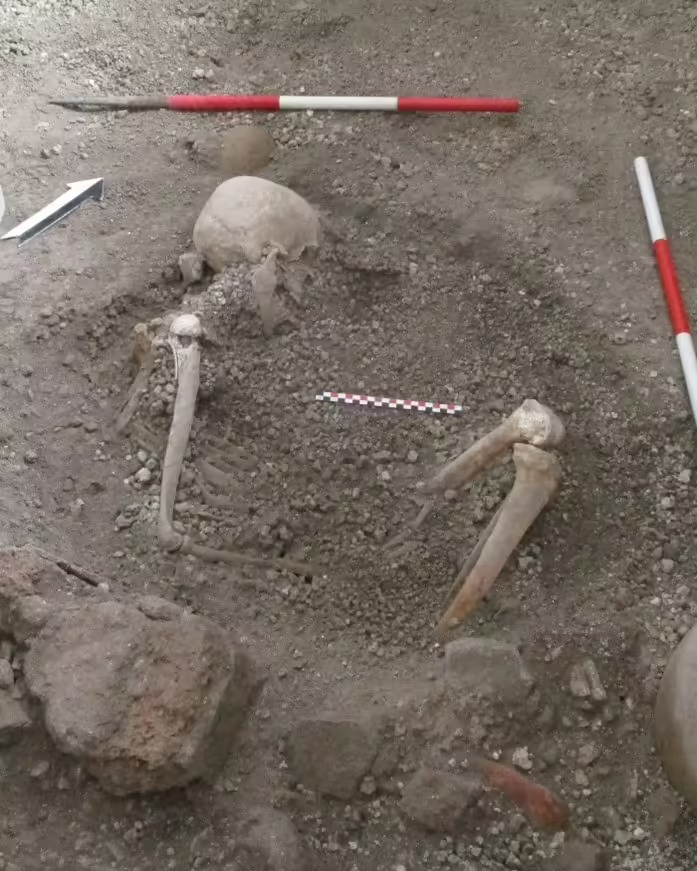Scientists Discover What Killed Survivors of Mount Vesuvius Eruption
- July 18, 2024
- 0
While the people of Pompeii were going about their normal daily business, a volcano erupted near their city. The column of ash, tephra and hot gases reached several
While the people of Pompeii were going about their normal daily business, a volcano erupted near their city. The column of ash, tephra and hot gases reached several
While the people of Pompeii were going about their normal daily business, a volcano erupted near their city. The column of ash, tephra and hot gases reached several kilometers high. Some tried to escape but could not. The authors of the new study explained why.
A year ago, researchers from the Archaeological Park “Pompeii” found the remains of two men who died during the eruption of Mount Vesuvius in the House of Chaste Lovers (named after the corresponding fresco). The skeletons were badly damaged, and archaeologists assumed that the walls of the building collapsed due to the earthquake.
However, it was not clear whether the earthquake caused their deaths or whether the bone damage occurred after death. Scientists from Italy’s National Institute of Geophysics and Volcanology (INGV) and the Pompeii Archaeological Park conducted an interdisciplinary study of both the skeletal remains and the site where they were found. The results are presented in a paper published in the journal Frontiers in Earth Science.
The eruption of Vesuvius in 79 AD is known to us from the description of Pliny the Younger. Combining his story with the results of archaeological excavations, several scientific groups immediately began a reconstruction of the eruption. They differ in the details, but all agree that it was a tragedy in two acts.
The first of these was the Plinian eruption, when Vesuvius threw up a huge column of ash and pumice. They fell and covered the area with a dense layer of lapilli (small particles of stone and ash). Pyroclastic flows descended a little later. This eruption lasted 18-20 hours.
Then there was a short lull, and the survivors even tried to leave Pompeii. But the third phase began: the Pelesian eruption. New pyroclastic flows formed (but without an explosion), two of which fell on Pompeii. According to Pliny the Younger, underground tremors were felt between the eruptions.
The previous earthquake in the Vesuvius region occurred on February 5, 1962. There was no eruption at that time, but Seneca the Younger reported its consequences in his “Natural Matters”: some buildings in Pompeii and Herculaneum were seriously damaged.
Remember that volcanic and seismic events can occur simultaneously or in rapid succession, meaning the effects of one eruption can dwarf the damage caused by earthquakes and vice versa.
The authors of the new study noted that the connection between the earthquake and the 1979 eruption has long been understood by scientists. But it is not clear whether the earthquake was merely the initial impetus for the tragedy, or whether people were harmed by aftershocks rather than by Vesuvius’ ash, lava and gases. The researchers planned to answer this question by examining the skeletons from the House of Chaste Lovers.
The remains belonged to deceased men in their 50s. Judging by the nature of the injuries, one was suddenly crushed by a falling wall and did not have time to react. The second tried to cover himself with a wooden object (door, table). Remains of this item were found on top of the skeleton.
Both men had compression injuries to their bones similar to injuries suffered by earthquake victims described in modern medical literature.

Both skeletons were covered in a thick layer of lapilli, a normal picture for Pompeii, as tephra had fallen over the city for hours. However, the researchers found that the ground beneath both skeletons was covered in lapis lazuli. After comparing these factors, the authors of the paper came to the following conclusion.
The eruption caught the people of Pompeii going about their normal daily business. When they saw the volcano erupt and a huge column of ash and pumice was thrown up, some tried to hide in their homes, saving many from the ash and rocks that fell on the city. But then aftershocks began as the walls of buildings collapsed.
Scientists believe that many residents of the city sought salvation in such temporary shelters, but when houses began to collapse due to the earthquake, some ran outside and were covered in ashes.
There is no reliable data yet on how many people died from volcanic eruptions and how many died from earthquake-related destruction. The authors plan to conduct further studies in this direction, taking into account how closely the picture of the city’s destruction and human deaths in the new excavations matches the earthquake descriptions.
Source: Port Altele
As an experienced journalist and author, Mary has been reporting on the latest news and trends for over 5 years. With a passion for uncovering the stories behind the headlines, Mary has earned a reputation as a trusted voice in the world of journalism. Her writing style is insightful, engaging and thought-provoking, as she takes a deep dive into the most pressing issues of our time.